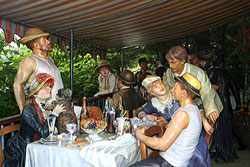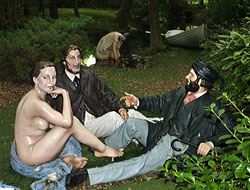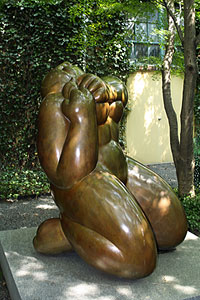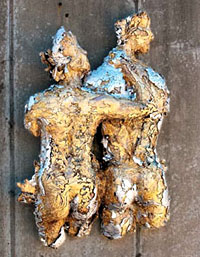Grounds for Sculpture: A Marriage of Nature and Art
 J. Seward Johnson, Jr., Were You Invited?, 2001,cast painted bronze, 132" x 288" x 204", Courtesy of The Sculpture Foundation, Inc., based on Pierre Auguste Renoir's painting, The Luncheon of the Boating Party
J. Seward Johnson, Jr., Were You Invited?, 2001,cast painted bronze, 132" x 288" x 204", Courtesy of The Sculpture Foundation, Inc., based on Pierre Auguste Renoir's painting, The Luncheon of the Boating Party Photo by Melanie Votaw
If you've never heard of Hamilton, New Jersey, you might be surprised to learn that it's a haven for sculpture. The township within an hour's drive from New York City is home to a 35-acre public sculpture park called Grounds for Sculpture. The word "park" hardly describes this place, which is an open-air gallery-garden with a collection of more than 250 sculptures and about 2,000 trees. These sculptures, many of them bronze, by artists from all over the world, are surrounded by beautiful landscaping that utilizes more than 100 species of plants, as well as ponds, courtyards, terraces, and pergolas. Many of the plants were collected from estates, abandoned nurseries, and construction sites.
Founded in 1992 and designed by architect Brian Carey of New York City's AC/BC Associates, the concept was born in the 1980's when bronze sculptor J. Seward Johnson, Jr. purchased some of the land near his studio that had once been the site of the New Jersey State Fairgrounds. By 1993, the park opened to the public, and it became a not-for-profit organization in 2000, relying on donations, grants, admission fees from visitors, and memberships. Some of the sculptures were purchased, some were donated, and most are on loan from The Sculpture Foundation, Inc., a charitable foundation that collects works of art.
"Our whole mission is to make sculpture accessible to all people," says Coby Green-Rifkin, Director of Marketing. "The way the park is set up, there are sculptures actually leading here on the major highway. We call that the bread crumb trail. It's part of our 'Sculpture on the Way' program. So, really, we're raising the profile of sculpture. We're trying to make it more accessible to the general public, make it very approachable."
 J. Seward Johnson, Jr., Déjeuner Déjá Vu, 1994, cast painted bronze, 62" x 132" x 360", Courtesy of The Sculpture Foundation, Inc., inspired by Manet's paintings Déjeuner Sur L'Herbe and Family Secret
J. Seward Johnson, Jr., Déjeuner Déjá Vu, 1994, cast painted bronze, 62" x 132" x 360", Courtesy of The Sculpture Foundation, Inc., inspired by Manet's paintings Déjeuner Sur L'Herbe and Family SecretPhoto by Melanie Votaw
While the sculptures represented are constructed of a variety of materials such as stone, wood, concrete, and glass, there are a large number of metal works in the park. The park features many bronze pieces, in addition to several works consisting of nickel, steel, aluminum, copper and iron. Sacred Grove by Toni Putnam is constructed of welded copper, and Nature's Laugh by Gunnar Theel is a mixed media piece incorporating copper, stainless steel, marine plywood, soil, and grass. Another of the artists working in mixed media is Brower Hatcher, who combines stainless rods with glass to create intricate web-like abstract sculptures.
As you would expect, there are numerous works by J. Seward Johnson, Jr. in the park, many of which are three-dimensional interpretations of Impressionist paintings. You might stumble upon a French family of bronze sculptures sitting on benches by a lake, life-size and painted realistically enough to cause you to do a double-take if you pass by without looking carefully. These works allow you to feel as though you're walking into an Impressionist painting, becoming a part of it. You can often even sit down next to a bronze sculpture and have your picture taken with it.
Some of these sculptures are within secluded wooded areas of the park. One such Johnson work is a bronze sculptural version of Edouard Manet's famous painting, Le Dejeuner sur l'Herbe, which Johnson has titled, Dejeuner Déjà vu. The sculpture includes the two gentlemen sitting on the ground with the naked woman, as well as the woman bathing in the background - except in this case, she's bathing in an actual body of water. One of the most ambitious works by Johnson in the park is a three-dimensional bronze rendering of all of the figures in Renoir's painting, Luncheon of the Boating Party, which Johnson has titled, Were You Invited? The artist's sense of humor is evident in the fact that he has added a few extra figures in the work, including himself and some artist friends who also have sculptures in the park. Visitors can actually step into the sculpture and pretend that they are part of the action.
Of course, not all of the sculptures in the park are realistic works like Johnson's. The majority of the pieces are abstract. In fact, one of Johnson's figures in the park, King Lear, is a sculpture that is not painted or realistic like the majority of his works on the grounds. Other abstract metal pieces run the gamut from fabricated to cast to bolted works or combinations of all three with natural finishes, complicated patinas, or paint.
For artists, one of the most appealing aspects of Grounds for Sculpture is that the landscaping is often altered to frame the art. The curator decides where to place the pieces, and a landscape architect and project manager work with the curator and the artist to determine how the work will look best and have the most impact. "All of the landscaping that is done here is done quite intentionally," says Green-Rifkin. "There are no accidents. Hills and valleys are created to support various sculptures. Waterways are built to support the sculptures. So, it's really an amazing feat of both landscape architecture and also what one can do with the aesthetics of combining sculpture with nature," she says. For example, Johnson's cast aluminum and Styrofoam work, Erotica Tropicallis, based on Henri Rousseau's painting, The Dream, is installed within a small - but very much alive - bamboo forest.
 Karen Peterson, The Listener, 1997, cast bronze, 59" x 42" x 40", Courtesy of The Sculpture Foundation, Inc.
Karen Peterson, The Listener, 1997, cast bronze, 59" x 42" x 40", Courtesy of The Sculpture Foundation, Inc.Photo by Melanie Votaw
Grounds for Sculpture has three restaurants, including Rat's, a more formal eatery with a wine list that is located next to a replica of Monet's Giverny lily pond and bridge. Perhaps the park's most dramatic piece is next to Rat's in a small body of water. The large-scale portrait by Philip Grausman of a woman's cast head is immersed in a constant stream of mist along its base.
The other restaurants are the Peacock Café, which serves sandwiches and pizza, and the Gazebo, where visitors can buy snacks and ice cream. There is also a museum shop with posters, postcards, books, gifts, and children's items.
Educational programs at Grounds for Sculpture include workshops for adults and children, such as sand casting instruction. Artist residencies, lectures, and tours are held to inform the public about sculpture, and these include a touch tour for the blind and tours for school children. There is even a "Tots on Tours" interactive program for 3- to 5-year-olds. Not all sculptures can be touched, but a marker on the ground next to each sculpture lets visitors know if it can be touched or not. The markers also name each sculpture, the artist, the medium, and year of the piece.
Corporate groups also visit the park and participate in team-building activities such as "sculpture hunts," during which they're given an hour to find 18 sculptures on the grounds. Most of these pieces are in hidden areas to make it more challenging. This causes the participants to look more carefully at the sculptures rather than just pass by them superficially as they might in a museum.
The sculptors represented in the park are both well-established and emerging names. An acquisition committee chooses the work, looking at portfolios and submissions sent by artists. While the majority of the works are outdoors, Grounds for Sculpture also has a museum and domestic arts building for indoor exhibits. New additions are made every season to the outdoor permanent collection, and group or one-person temporary exhibitions are held indoors periodically.
Some of the buildings used by the New Jersey State Fair remain on the site, although the land was mostly rubble and dirt before Grounds for Sculpture took over the land. There is even a rumor that an elephant is buried beneath the former grandstand. In fact, the current Museum building once housed small livestock, although the building was moved from its original location on the grounds.
 Carole A. Feuerman, Zeus and Hera II, 2004, cast bronze and aluminum, 40" x 36" x 7", Gift of Dr. Craig Feuerman
Carole A. Feuerman, Zeus and Hera II, 2004, cast bronze and aluminum, 40" x 36" x 7", Gift of Dr. Craig Feuerman Photo courtesy of Ricardo Barros
South African artist Isaac Witkin (1936-2006), who apprenticed with Henry Moore and later moved to New Jersey, is well represented at Grounds for Sculpture with eight pieces in several different media. Often creating organic forms, Witkin was the first artist to have a sculpture in the park. One of his cast bronze pieces, "Ode to a Possum," evolved when he accidentally killed a possum that was hiding in his studio. He enclosed the bones of the animal within the metal as a tribute. Another artist, Robert Ressler, utilizes trees that have been cut down or have succumbed to disease, carving them, casting them in bronze, and often painting them in bright colors. Dana Loren Stewart, who has a studio and foundry in New Jersey, will be the park's featured artist in November. He creates whimsical cast bronze animals with exaggerated tails, and Grounds for Sculpture contains more than a dozen of these "playful beasts."
Carole A. Feuerman, who has a studio and foundry in New York City, has three works at Grounds for Sculpture. Her sculptures are in the personal collections of former U.S. President Bill Clinton, Dr. Henry Kissinger, and Mikhail Gorbachev, among others. Her early work was primarily realistic casts of people. One such piece in the park is a life-size painted figure called Employee Shower. Now, Feuerman concentrates on expressionistic metal figures of gods and goddesses. Her wall sculpture at Grounds for Sculpture entitled, Zeus and Hera II, is a textured piece in cast bronze and aluminum.
For Feuerman, creating sculpture is a mystical experience.
"I elect an exact time astrologically to birth them. After I make them, they're covered in sand, and they're uncovered at a certain time which is like a birth time," she says. "So, it's a very spiritual kind of experience in doing this." She knows that she can achieve certain effects depending on how she pours the molten metal. "I concentrate, kind of meditate on a feeling that I want to portray, and it relates to the metals and how they come out. It's interesting because I can translate [feelings] right into the metal," she says.
Feuerman has created her own technique. "I wear all this special equipment, and I'm completely protected in asbestos clothing and gloves. I look like the tin man in the Wizard of Oz," she says. "I had a sand pit built for me at the foundry, so I have plenty of room to splatter the metal. Sometimes, I drip it. It depends on the technique I want - if I want these drip shapes or if I want splashes. And by using various metals, I get various colors and textures. When I cover the molten bronze, I can achieve iridescent colors by smothering the molten metal. So, it's not just that they're birthed at a certain time in a ritualistic manner, but they get a beautiful patina that way which is all natural. So, there's no patina added," she says.
Feuerman is just one of more than 130 artists represented at Grounds for Sculpture. The park is so large that it would be difficult to see all of the sculptures in one visit. "Someone can come and spend a couple of hours, and they'll get a taste," says Green-Rifkin. "But there's no way they could see the whole park in that period of time. We recommend that they come on more than one occasion to really get the full impact of the park."
In fact, there are so many works to discover that the best way to view them is probably to wander, which allows for that element of surprise. "It's very important to us that people really do have the opportunity to approach it on their own terms," Green-Rifkin says. "For instance, we've got a map that features over 250 sculptures, but we don't have a specific path. We don't say 'start here' and 'go here.' It's really about people discovering and exploring for themselves."
Resources:
Also in this Issue:
- Grounds for Sculpture: A Marriage of Nature and Art
- Collecting Colonial Era Copper Prints
- America's First Copper Paint
- Depicting Nature in Metal
- Julia Child's Copper Pots Reunited at the Smithsonian
